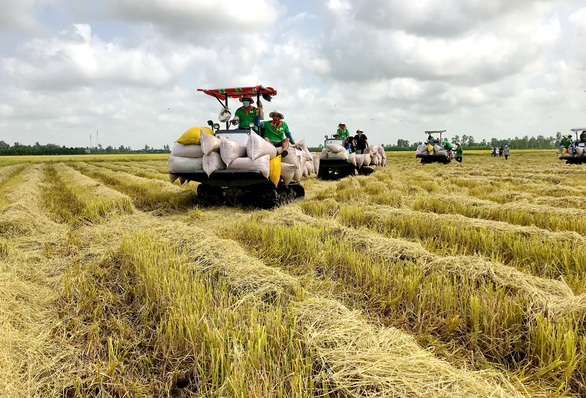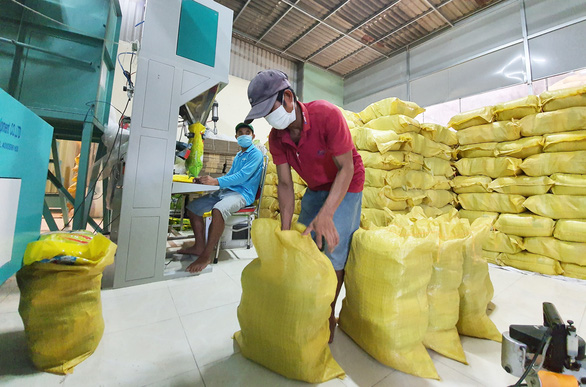Despite the scarcity of food worldwide and some countries’ food export suspension to stabilize prices, Vietnam is capable of speeding up production to control the prices of food products and keep supplying to the world.
In the first months of the year, the prices of many food products rose over the same period last year, which was attributed to rising input costs.
Nevertheless, the country is not concerned about a possible shortage of foodstuffs.
No worry about shortage of food
Pig herds were forecast to be scaled down and the number of swine raised by households may halve compared to last year because of rising animal feed prices, according to Nguyen Kim Doan, vice-chairman of the Dong Nai Livestock Association in the namesake province, just outside Ho Chi Minh City.
Le Xuan Huy, deputy general director of C.P. Vietnam Corporation, shared the view, saying that pig herds raised by households had fallen.
However, if large companies increase drifts of hogs, the pork supply will be ensured.
“As the number of pigs has risen 5-10 percent over last year, C.P. expected to release some 19,000 to 20,000 swine per day,” Huy added.
The director of a foreign-invested livestock company in Vietnam said that the supply of pork, poultry, and eggs would be plentiful until the end of the year thanks to the incremental pig droves of large livestock companies.
Yet, prices have surged due to the input cost hike but the spike has been acceptable.
In reality, bran rates have shot up since early 2020, while the prices of live pigs, poultry, and eggs have edged up.
Given the current situation, Vietnam does not need to worry about any meat shortage until the end of the year, the director noted.
“If the U.S., Argentina, and India limit or suspend the exportation of wheat, corn, and soybeans, the local livestock sector may face difficulties because of its dependence on imported materials," he commented.
“This assumption is forecast to happen in 2023 and the whole world will be affected, so countries have striven to prevent such a situation."
Reducing production cost
According to a company processing rice for export in District 7, Ho Chi Minh City, the grain supply can satisfy local demand, as most rice processing firms have large warehouses.
Vietnam's stable material sources will ensure a sufficient, even abundant, rice supply despite the global food dearth, a representative of the company said.
Meanwhile, Truong Kien Tho, deputy director of the Department of Agriculture and Rural Development in rice-producing An Giang Province, estimated the province’s rice output at over four million metric tons this year.
The department has directed relevant bodies to publicize production cost saving measures.
Le Quoc Dien, deputy director of the Department of Agriculture and Rural Development in Dong Thap Province, another major rice producer, said that the province’s cultivation area is 491,000 hectares and the rice output is more than 3.2 million metric tons.
In the first five months of this year, the province has exported more than 136,000 metric tons of the grain, earning US$71.2 million.
In the context of agricultural supplies getting more expensive, the department has enhanced technology application to rice production to reduce production cost.
Golden opportunities for export
Food security is no longer a concern in Vietnam, food production and export companies said.
The country is also a leading exporter of many kinds of food and foodstuffs to the world.
|
|
| ST25 rice, a premium grain, is packaged at a factory in Soc Trang Province, southern Vietnam. Photo: Chi Quoc / Tuoi Tre |
With many countries shrinking food exports, Vietnam should take advantage of the situation to strengthen its position as a leading food provider.
The demand for seafood products, especially shrimp, has bounced back as the COVID-19 pandemic has been kept at bay and life has returned to normal, said Do Ngoc Tai, general director of Tai Kim Anh Co. Ltd..
In the first five months of the year, shrimp exports to the U.S., Europe, Japan, and South Korea have surged.
“If transport costs are kept at reasonable levels, seafood exports will be promising until the end of the year," Tai noted.
Vo Cong Thuc, director of quality at Loc Troi Group, a rice company, saw a golden opportunity for rice enterprises: the COVID-19 pandemic and the Russia-Ukraine military conflict have reduced wheat supply.
Moreover, India, a large rice exporter, has consricted its overseas shipments.
Vietnam has a rice crop every three months so the country’s rice supply is stable.
Abundant seafood
Vo Van Chieu, director of the Soc Trang Department of Industry and Trade, said that after recovering from the pandemic, the province’s shrimp export was a bright spot in January-April, soaring 41.5 percent year on year to over $375 million.
According to a seafood firm in Cam Ranh City, Khanh Hoa Province, large inventories have helped maintain its seafood supply since early this year.
When facing difficulties in export, the company focused on the domestic market.
Its seafood sales after the health crisis have risen 20 percent over last year.
A representative of the Vietnam Food Association said military conflicts, the COVID-19 pandemic, and rising fuel prices scaled down food production in some areas while sending product prices soaring.
Therefore, some countries have limited or even suspended the export of some food products.
However, the challenges are temporary, the representative affirmed, saying that Vietnam should seize the initiative in the supply of materials replacing wheat, fertilizers, and animal feed to ensure sustainable production.
Ensuring food security
Nguyen Nhu Cuong, head of the Department of Crop Production under the Ministry of Agriculture and Rural Development, said the country will cultivate some 7.2 million hectares of rice this year.
Cuong added the ministry had worked out solutions for responding to natural disasters and salinity intrusion.
It has directed localities to draw up production plans and the Directorate of Water Resources as well as the Plant Protection Department to keep a close watch on local production to promptly deal with calamities and diseases, the official added.
“The Ministry of Agriculture and Rural Development has set the target of over 7.2 hectares and some 43 million metric tons of rice at any cost to ensure the country’s food security and other purposes, such as animal feed production and exports,” he underlined.
The Department of Crop Production has been reviewing current rice cultivation processes and proposed more techniques to lower input costs, while ensuring the interests of rice farmers and production plants.
Amid the rising demand for food imports in some countries, Cuong said the central government should adjust export policy to ensure domestic food security.
With 43 million metric tons of rice produced in the country and local consumption of only around 15 million metric tons, Vietnamese food security will not be a problem in the long term.
|
|
| An employee of Thy Tho slaughterhouse in Long Khanh City, Dong Nai Province, southern Vietnam checks slaughtered pigs before sending them to supermarkets. Photo: A Loc / Tuoi Tre |
Increasing import demand will send export prices up, which will spur farmers’ production, Cuong added.
Regarding many nations’ ban on the exportation of food and foodstuffs, Dr. Vo Hung Dung, former director of the Vietnam Chamber of Commerce and Industry – Can Tho Branch, told Tuoi Tre (Youth) newspaper that Vietnam should not impose a similar prohibition.
Vietnam has gained experience from dealing with the 2008 food crisis and it has a firm food production foundation, Dung explained.
In addition, the security in Vietnam and the region has been stable so there is no need to ban the exportation of rice or seafood.
But it is necessary to reduce taxes on input materials to cut production costs, he said.
Local authorities and the agriculture sector should pave the way for farmers to accelerate their production to supply food to the market.
"Favorable conditions should be implemented to help them feel confident in the policies of the Party and the state," Dung recommended.
Like us on Facebook or follow us on Twitter to get the latest news about Vietnam!



















































